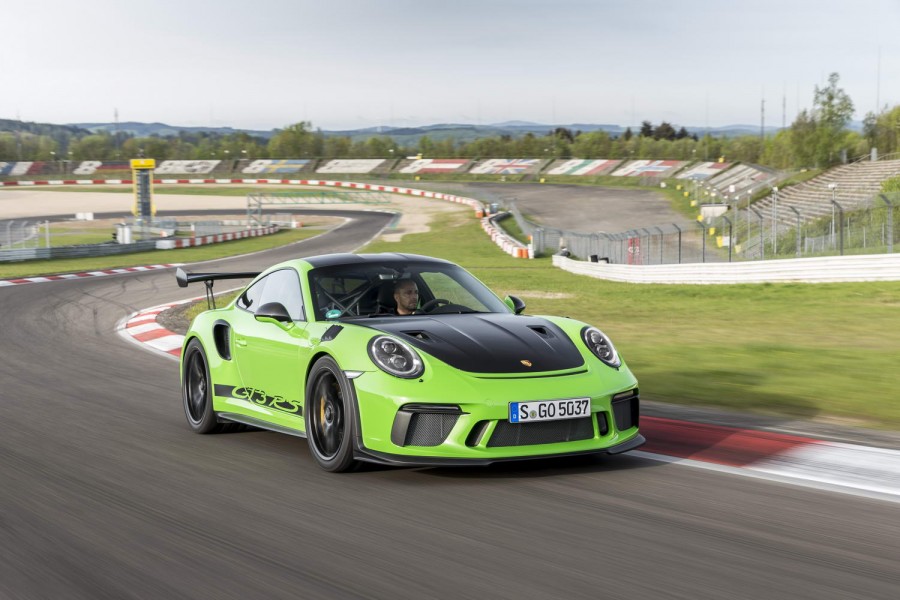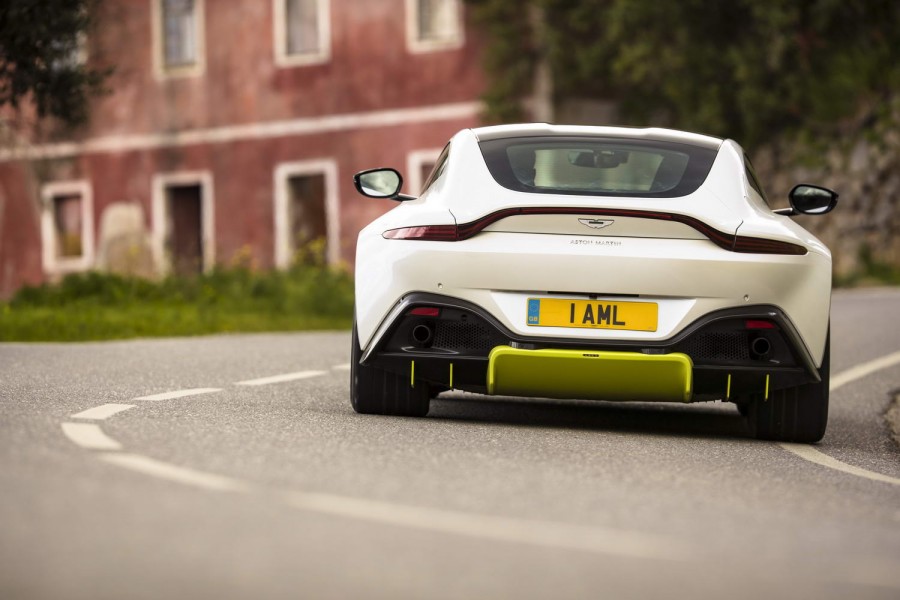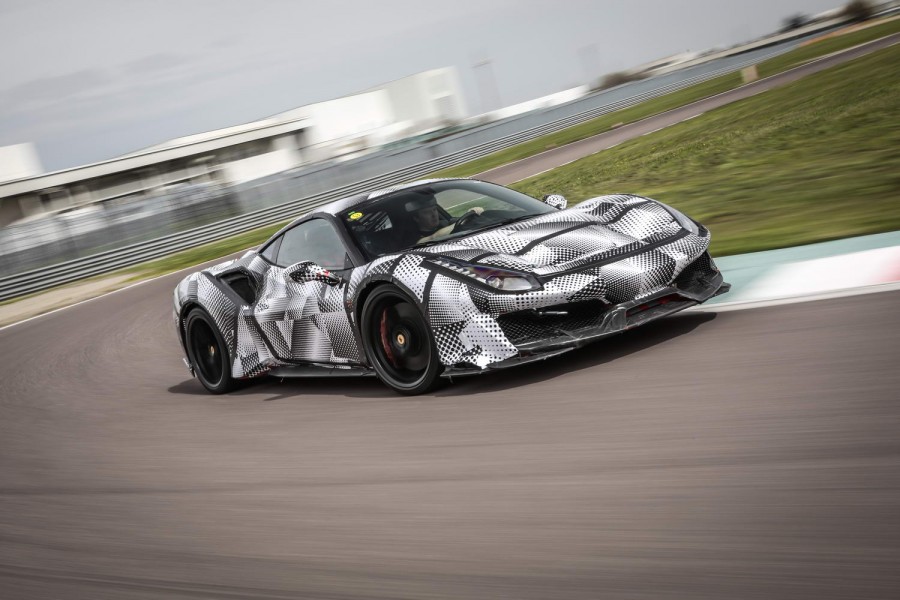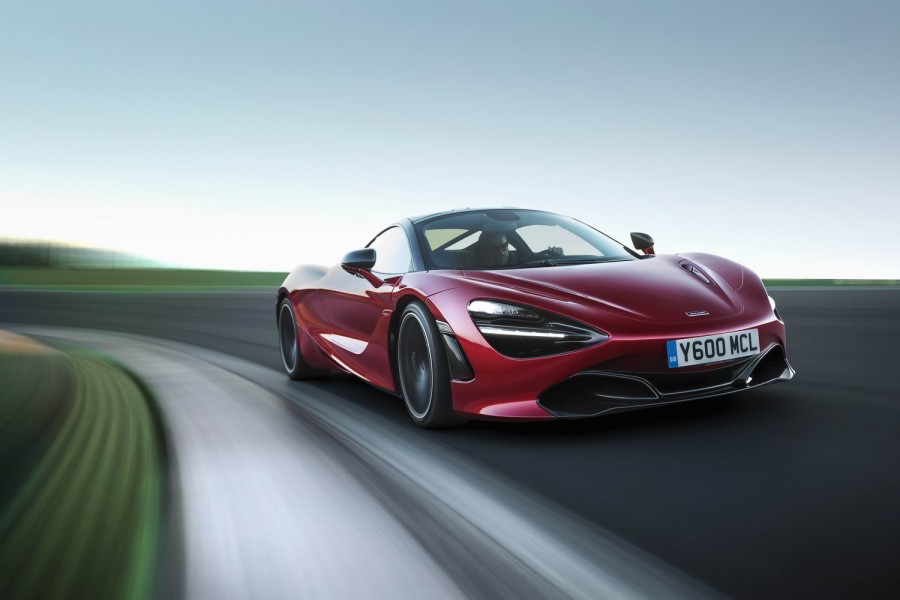The second iteration of the 991-era Porsche 911 GT3 RS looks every bit the race car for the road and backing up that image are performance credentials that show uncompromising attention to engineering detail. The hybridisation and electrification of cars is fast approaching, even for Porsche, and its effect on driving emotion remains a relative unknown. With that in mind, this naturally aspirated and uncompromising 911 GT3 RS could genuinely be one of the last authentic driving experiences. Soak it up.
In the metal
The already extreme styling of the Porsche 911 GT3 RS moves up another level for this 911.2 version. But, as you would expect from Porsche's motorsport department, every alteration and tweak has been carried out with the single goal in mind - making the car even faster.
Built using the wide body from the 911 Turbo, the GT3 RS uses a magnesium roof to bring weight and the centre of gravity down. That huge rear wing is beautifully made of carbon fibre and gets new endplates to better manage flow as it scythes through the air. The front wings are formed in carbon fibre, too, while the bumpers at either end are made from a light polyurethane that saves 1.5kg each.
Larger vented slats on top of the car's front wings improve air extraction from the wheel wells, which is helpful as there isn't much room in there with the car wearing 20-inch rims on the front and 21-inch wheels on the rear. The bonnet gains a pair of NACA ducts that feed air downwards through channels made into the body-in-white to cool the brake callipers and discs. In all the car drops 6kg in weight over the previous GT3 RS.
If that isn't extreme enough for you, there's always the optional Weissach package; this replaces the 1.1mm thick magnesium roof with one made from carbon shedding even more grams. The pack also adds magnesium wheels, carbon fibre anti-roll bars, a clear-coated carbon bonnet, a bolted-in titanium roll cage (12 kilograms lighter than the steel one) and SportDesign carbon-weave mirror shells. Even the carpet underneath the front seats is removed, while the steering wheel cover and gear shift paddle materials are replaced with CFRP (carbon fibre reinforced plastic). All in this shaves a further 30 kilograms from the car.
In its standard setup, the GT3 RS generates up to 144kg of downforce at 200km/h, but owners can add more through a quick series of adjustments. Inserts in the front bumper section come out with the undoing of a few screws, while the rear wing's angle of attack is easily adjusted to help press those 325/30 rear tyres into the tarmac.
Subtle as the changes are in comparison to the last RS, they do make a difference, even if, Andreas Preuninger, Director of Porsche's GT Model Line, admits you might "need an atomic clock to measure it." It all adds up though, as the new car recently set a new lap record at the Nürburgring-Nordschleife of 6 minutes 56.4 seconds, cutting 24 seconds off the previous model's time. A sizeable part of that astonishing improvement in lap time is down to the new suspension setup. The new record was apparently set over just four laps during a free hour in track testing. Some inside Porsche acknowledge that it would be able to set an even faster time, but when the fastest lap time went up, they said 'enough' and left it at that.
Driving it
If there's one aspect of the new GT3 RS that defines it, it's the engine. A glance at the technical specification shows a mere 20hp increase to 520hp, with torque growing by 10Nm to 470Nm. Internally much has changed, however. The crankshaft uses larger diameter bearings, the cylinders are plasma-coated to reduce friction losses and a new crankshaft design feeding oil to the big-end bearings requires less oil and oil pressure allowing for a more efficient oil pump that takes power from the engine. Change like this add up to what is now the most powerful naturally aspirated engine Porsche has ever put into a road car.
Not everyone is going to get overly excited by the mechanical advancement in the engine, but few will disagree on this one point: the flat-six engine residing in the rear of the GT3 RS sounds incredible as it screams towards its 9,000rpm redline. How the engine note changes and develops as the revs rise is something that no amount of sound recording can adequately do justice to. Above 6,750rpm it's nothing short of intoxicating and, aside from the phenomenal and seemingly unending power delivery, just how this remains an entirely road legal car that complies with noise regulations is a wonder. Preuninger concedes that, were it not for the various rules governing road cars, the engine could produce more than 600hp.
Incredibly, the PDK transmission now shifts even faster than before, in a way that feels like it's telepathically connected to you. In the nanosecond it takes your brain to send an electrical impulse to your finger to pull on the paddle shifter, the next gear is engaged. You could leave it in full auto mode if you so desired. There will undoubtedly be purists who say a manual is better, but in this instance, the PDK only adds to the experience.
Through fast sweeping bends on the Nürburgring race track, the Michelin Pilot Sport Cup 2s make the car feel glued to the surface, adding to confidence levels. But there is far more than sticky tyres at work here. Thorough revisions to the suspension setup see it become closer to that employed in the 911 Cup car. Ball joints on all suspension arms provide greater precision and how it behaves both on the road and on track under load renews the widely-held belief that Porsche remains the master of chassis setup.
The steering is ultra-precise and so positive in its feedback and weighting that it's easy to forget that it's an electrically assisted system. If you still have doubts that such an arrangement can work, then you need to drive this car. It's nothing short of sublime at any speed.
Speaking of speed, as it increases so too do the grips levels. There are prodigious amounts of it. At 200km/h the RS generates more than double the downforce a GT3 manages. Despite that vast wing forcing the rear tyres into the tarmac and creating drag, you can hit 312km/h if you can find a straight long enough.
Just as promising is that the car delivers equally impressive performance on the road. Some limited time in the area around the Nürburgring, even in the damp, revealed a surprising degree of compliance in the suspension. The active rear-axle steering adds benefit in the tighter corners, helping to mask the car's wide track (which is narrower at the rear by 31mm).
It's far from being a comfortable grand tourer, and only the most dedicated will want to take it on a Pan-European blast, but it is usable to a degree. When you aren't pushing on hard in the car, the transmission lets the engine settle down, and it cruises along smoothly in top gear. But we'd only imagine doing this as a temporary respite between the next snaking section of empty tarmac.
What you get for your money
You could get the standard off-the-shelf 911 GT3 RS and be phenomenally happy with it. Aside from being a hardcore road-legal track car it features exquisite levels of finish and features useful items such as a connected infotainment system. One option that is indeed worth adding is the lift system for the front end. This hydraulic system raises the nose of the car by 30 millimetres, which should be enough to cope with speed humps and multi-storey car parks. It operates on the fly at up to 50km/h too.
Porsche offers a Clubsport package at no additional cost, adding a roll-over bar, manual fire extinguisher, preparation for a battery disconnect switch and a six-point harness. A useful box to tick if you're planning on doing some track days. But if you want to get the most from your 911 GT3 RS, the Weissach Package is a must.
Summary
It's hard to believe that Porsche could make the 911 GT3 RS any better, but through fastidious attention to detail it has. The new one is certainly one of the most focused track-ready cars that money can buy today and potentially the last of an incredible breed of great naturally aspirated sports cars money can buy.































